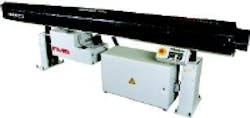Get more out of turning operations
Boosting the productivity of a lathe operation by at least 50 percent is as easy as adding a barfeeder. Such productivity gains stem from the fact that barfeeders provide a constant supply of raw part material to lathes, allow for unattended operation and lend support for machining at fast speeds.
Without barfeeders, a shop has to cut raw stock into manageable slugs, move them to the turning machine and manually load and unload the machine. Those activities diminish machine throughput because they extend non-cut times between parts.
Barfeeders, on the other hand, automatically feed long lengths of barstock into lathes for hours of unattended operation, freeing machine operators for other duties such as secondary operations, part cleaning and packaging.
Lathes basically cost about the same no matter where they are purchased, but the cost of operating them varies when factoring in labor, or a manufacturing facility's burden rate. Affordable automation, such as barfeeders, eliminates the manual burden rate and allows shops to compete globally with countries that have low labor rates. In addition, manufacturing facilities can continually improve throughput with such automation.
The goal is not necessarily to replace operators with barfeeders, but to set up machines with a constant source of raw materials that allows them to run unattended at night and on weekends. So shops can schedule and set up work during the day shift and run the jobs at a low cost per-hour while increasing their cutting times and getting a greater return from their investment in the machine tool.
With a $15,000 barfeeder, using it over a five-year period for 35 hours per week, 50 weeks of the year — for a total of 8,750 hours — the hourly cost of ownership is $1.71 per hour. However, that is a conservative estimate. With careful scheduling, their use can be extended to nights, weekends and holidays, and the hourly cost could drop as low as $0.34 per hour. No operators in the world work for such a low hourly rate.
The long and short of it
Two common styles of barfeeders are single-bar tube and magazine, and the magazine styles are available as long or short versions. Single-bar tube feeders typically work with Swiss-style sliding-headstock machines for loading wire-gage material and barstock measuring up to 1.750 in. in diameter. While these feeders require shops to load bars one at a time, the machines they feed are typically running small, short complex parts with long cycle times out of 12-ft.-long bars that provide one or two shifts of unattended operation.
Magazine-style barfeeders hold multiple pieces of barstock in different shapes and diameters and feed one bar after the other into a lathe. Changeovers from different bar sizes and shapes are quick, easy and automatic, taking as little as 15 seconds for some models. Loading magazines can be done while the barfeeder and lathe are working. Such fast changeovers mean barfeeders could be used on low and medium-volume jobs as well as the high-volume jobs they are usually associated with.
The long styles of magazine barfeeders handle 12-ft.-long barstock and can keep lathes running unattended for multiple shifts. Short-style magazine feeders provide up to 8 hours of unattended lathe operation feeding bar lengths typically 3 or 4 ft. long. The bar lengths are determined by the headstock lengths in the lathes that they feed because machine headstocks support bars when running a short-version feeder.
By not having to rely on the barfeeder for back-end bar support, shops can run lathe spindles to their maximum speeds. That is especially beneficial when using carbide, ceramic and Cermet cutting tools that excel at high speeds for producing precision surface finishes. Short-version magazine barfeeders also take up less floorspace.
Some styles of single-bar tube and long-version magazine barfeeders offer significant back-end bar support, so shops are not limited in the turning speeds they run when they use them. In some instances, shops can double spindle rpm to increase surface feeds and decrease part cycle times.
Barfeeders are equipped with either hydrodynamic or hydrostatic support systems. In ideal conditions, hydrodynamic systems offer stability at turning speeds up to 1,600 sfm, while hydrostatic ones handle speeds up to 3,000 sfm.
Do the mathUsing a $15,000 barfeeder 35 hours per week, 50 weeks of the year for a total of 1,750 hours a year, or 8,750 hours over five years, costs $1.71 per hour. Using the same machine days and nights, weekends and holidays (24/7) for a total of 8,736 hours a year, or 43,680 hours over five years, costs $0.34 per hour. In reality, the costs are somewhere in the middle, but those hourly rates can help to make any shop competitive. |
Sources for this article include:• Bucci Industries USA Inc. • Edge Technologies • Lexair Inc. • LNS America Inc. • SMW Systems Inc. |
AM for American Manufacturing is an ongoing initiative to provide content that addresses the four key issues of competitiveness: operational excellence, workforce preparedness, regulatory costs and the international playing field.
